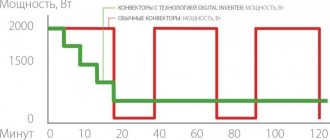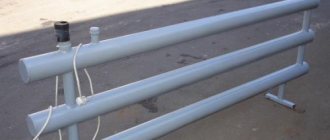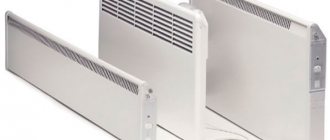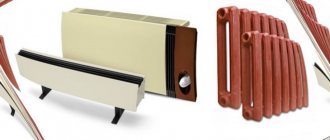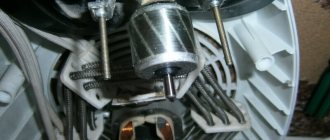The season of frost and blizzards is just gaining strength, so a heater may be needed more than ever. The default standard for a city apartment are oil radiators and convectors, it would seem: buy and be happy. However, not everything is as simple as it seems at first. Each type of heater performs its own specific tasks, although it serves one purpose - heating the premises.
Let's start with the fact that both oil and convector heaters are thermal electrical appliances, so calculating the area of the room that these devices can heat is quite simple. To do this, you need to know the power of the device, which should be divided by 100 to thus obtain the maximum area that it can warm. If your room has more than one window, you should add 100 or even 200 W to the power of the device.
For example, if you need to heat a corner room whose area is 15 square meters. m, you should multiply 15 by 100 and add another 200 W. As a result, you will get the power of the desired device - 1700 W.
What is the difference between a convector and an oil heater?
Oil and convection heaters are essentially different technical devices. Their work is aimed at achieving the same goal - warming the air, but they work on different principles.
An oil heater is an electric radiator whose coolant is mineral oil. The surface of the device is heated to a temperature of 80 to 110 ºC. There are two main types of oil heaters - panel and sectional. In the first, the oil is located in a flat reservoir, and the second type is characterized by the presence of several sections in the radiator.
A convector is a device that heats a room by air convection. Its main advantage is safety.
Comment! During operation, the body does not heat up much, and touching it does not leave burns on the body.
Operating principle, advantages and disadvantages
Most often, electric convectors or oil heaters are purchased to heat rooms. The principle of their operation is based on the fast and efficient heating of air, the movement of which in each of these devices occurs in its own way. In addition, there is a noticeable difference in cost, fundamental design, power, overall dimensions and other characteristics.
In order to answer the question of which is better - a convector or an oil heater, it is necessary to consider the features of their technical design, as well as operational advantages and disadvantages. At the same time, we will compare modern designs, and not those models that were developed by Soviet and Chinese industry and were widely offered for sale 10 years ago.
Pros and cons of convector and oil heaters
To understand the difference between a convector and an oil heater, you need to take a closer look at their advantages and disadvantages.
Oil heaters are popular due to a number of advantages:
- low cost compared to other types of heating devices;
- low electricity consumption compared to other types of heating;
- accumulate heat and maintain the room temperature for a long time after switching off;
- installation does not require special skills (you need to find a safe place for it, plug it into a power outlet and adjust the temperature regulator on the panel);
- quiet operation, which is sometimes very important;
- The small size allows you to install the oil pan anywhere.
Like any devices, in addition to advantages, they have some disadvantages:
- uneven air heating;
- low efficiency (coefficient of efficiency), because heat is spent on heating the device body;
- heats the air for a long time.
For comparison, it is proposed to study the advantages of a convector heater:
- the hollow design allows the air to be heated evenly;
- the room heats up many times faster than when using other heating equipment;
- convectors can completely replace central heating;
- complete safety.
Convectors also have disadvantages:
- they can create a draft;
- risk of overheating due to prolonged operation;
- high price.
The choice between heating devices is not obvious and depends on the room (office, apartment, private house, etc.)
Temperature control and power consumption
Convectors, like oil batteries, have their own mechanical thermostat. However, its error due to the correct mixing of cold and warm flows near the heater itself is minimal and amounts to less than 1 degree.

Due to more accurate operation of the thermostat, the continuous operation time of the convector is also adjusted. This results in greater energy efficiency and lower power consumption.
At the same time, the air in the room warms up more evenly. You won’t have too much of a temperature difference in different corners, even if you don’t place it in the middle of the room, but hang it close to some wall.

If you don’t really trust all these stories about efficiency, just compare the energy efficiency or energy saving class of oil heaters and convectors. On stamps from leading brands, it is usually indicated.

So, even the best oil coolers have the worst class - D. And for convectors, it is usually no lower - A. There are some models with the highest class - A+++.
In some European countries, it is even officially prohibited to sell and plug in such electrical appliances with an energy efficiency class below A.
Comparison of oil radiator and convector
The difference between a convector and an oil heater is significant, but not everyone sees the difference. In addition to the fact that both devices generate heat, they differ in technical characteristics:
| Parameter/Option | Oil heater | Convector |
| Heating time | Long, about 25-35 minutes after switching on | On average 5 minutes, as it immediately warms up the air, unlike the competing model |
| Energy efficiency | Low (consumes a lot of energy) | High (economical even with round-the-clock heating) |
| Safety | The surface becomes very hot and the device must not be left unattended (with the exception of models with a protective screen). | Safe because the body heats up to 40 ºC and can be left unattended and used in a room with small children and animals |
| Comfort | Not very convenient to use due to danger | Convenient because there are wall, floor, large and small models |
| Lifetime | Short (up to 5 years) | Long (up to 15 years) |
Judging by the table, we can conclude that a convector is better than oil heaters. They are considered a relic of past years; they are now rarely used in everyday life. Despite this, both types have disadvantages. For example, they dry out the air, raise dust, take a long time to warm the room and draw electricity.
Which is more economical: oil heater or convector
An oil-fired device warms up more slowly than a convector device, despite the fact that it has a simple and relaxed design. It needs time to set the temperature of the internal tubular electric heater, which will warm up the oil, then the housing, and then heat transfer will begin. Due to this, more energy will be required for heating. The convector warms the first batch of air within a minute after switching on.
The detailed structure of the convector will help you understand the principle of its operation.
What heats better: convector or oil radiator
Both types of equipment heat the air, but in different ways. The oil radiator first warms itself up to 80-110 ºC, and then begins to heat the area around itself. Then the warmer air rises up, and the heater warms up the one below, which is still cold. Thus, the overall temperature in the room increases. But at the same time, it is impossible to achieve a uniform regime in the room. Therefore, closer to the radiator it will be warmer, further away it will be cooler.
The operation of a convector is based on the principle of physical convection, that is, mixing cold air with warm air. This allows you to achieve an even temperature throughout the room. There is a heating element at the bottom of the device, and holes for air ventilation at the top. Thus, it passes through the convector and warms up.
Important! The air is initially already inside the convector, and it heats up in 15 seconds when turned on, after which it begins to heat the room.
Due to the fact that a convection-type device quickly and safely warms up the air, electric autonomous heating is installed on its basis, which completely replaces centralized heating. To do this, batteries are mounted on the walls in the rooms and connected to one rheostat, on which the switching on and the desired temperature are regulated.
Which is safer: convector or oil heater
In addition to warming the air, it is important that the heater is safe. This is especially true for pet owners and parents of small children. According to this criterion, preference should be given to an electric convector. It has a hollow body with a slight extension at the top. The heating element is located at the bottom, and the rest of the space is occupied by air, which is constantly converted with cold air to create the ideal temperature in the room.
The oil heater warms up completely, that is, its panel or sections become hot, depending on the model. It is less safe than direct heaters, but it should not be left unattended for long periods of time. The oil inside is flammable, and the device may explode if used incorrectly.
Regarding the environmental factor, both heaters are equally safe. But they negatively affect the air quality in the room because they dry it out. It is recommended to use a humidifier when using heaters frequently, especially if there is a small child in the house.
Comparison of oil heater and convector sizes
Dimensions vary by type and model. Typically, convectors are smaller and more compact, due to which they take up little space. In addition, they can be floor-mounted or wall-mounted, while oil radiators are only available in floor-mounted versions. Despite this, both types provide high-quality heating, which is why they have been competing in the market for many years.
In terms of weight, the largest convectors weigh up to 10 kg, and radiators weigh 20 and 25 kg. Wall-mounted convection-type models are small and light – usually no more than 5 kg. But it is worth noting that they warm up the room worse and are suitable for a small room with dimensions of no more than 11 square meters. m.
Durability and service life
To heat a large room, it is recommended to use several oil heaters, which are plugged into different sockets.
Another difference between a convector and an oil heater is the service life of the device. Manufacturers indicate the warranty period individually for each model. Durability also depends on frequency of use. If you turn on several convectors in different rooms, you can install a rheostat on them, which will save energy.
Cost comparison
There is also a difference in price between convectors and oil radiators. The former are more expensive, but they also last longer. If the oil seal needs to be changed every 5-10 years, then an electric heater can last up to 20 years with proper operation. In recent years, the Altis Eco Boost 2 CHG-BD1 convector has been considered the best model.
Its cost varies depending on the point of sale, but on average it is up to 8 thousand rubles. The Finnish model ENSTO BETA mini EPHBEM is also popular, the approximate cost of which is 5.5 thousand rubles.
Advice! High-quality oil pans can be purchased at prices ranging from 1 to 3 thousand rubles.
Oil battery

This is perhaps the most classic type of heater. It works on the principle of heat transfer.
In this case, significant heat loss may occur.

After all, it first contains:
- heating element heats up inside
- then it heats up the oil
- only after this do the battery walls heat up
- and at the end, they transfer heat to the nearest space near the oil pan

Therefore, in order to warm up the entire room faster, it is initially placed almost in the center of the room. If you push it into a corner or lean it against the wall, you will wait a very long time for heat.
Moreover, the minimum distances from walls and from surrounding objects are usually regulated by the safety rules for placing such batteries.

If there is no air movement in the room, then until the heated volume of air space near the heater itself passes to the neighboring layers, and they, in turn, give off heat further along the chain, a very, very long time passes.
Of course, if you are sitting near the radiator itself, you will be hot. But as soon as you move to a sofa or chair, away from the radiator, the feeling of warmth suddenly disappears.

As a result, it turns out that a comfortable and uniform temperature in a relatively large room (living room, bedroom) cannot be achieved using an oil radiator.

Moreover, the bulk of the cold air flow is always located below. And the warm air from the radiator immediately rises, without in any way warming up the layer near the floor.
Therefore, even if you have such a heater in the room, you still have to constantly wear slippers.

The built-in mechanical thermostat is responsible for the question of the frequency of switching on and off oil batteries. Without such devices, it is generally not recommended to buy this type of heater.
So, due to the fact that the air near the battery itself is constantly warmed up much more than in the entire room, its operation error of 3 degrees is considered almost the norm. Although sometimes it reaches 5-7C.

What problem does this pose for you personally? And the trouble here is that the oil engine simply does not have time to adequately respond to the rate of change in temperature outside.

As a result, you experience constant discomfort. The room will either be very overheated, or it will be periodically cool, even with the battery constantly on.
And the point here is not the heat loss of the room, windows or walls. Namely, the incorrect operation of the heating device.
Which heaters are better: oil or convector
To fully understand what is better, convector or oil heaters, you need to compare their main characteristics:
- time for heating the air in the room. In an oil radiator, the heating element is first heated, then it heats the oil, which transfers heat to the body, which already begins to heat the air. In a convector, the air is heated immediately. It is worth understanding that if you are going to buy an electric oil heater with a fan, then it will heat the air at the same speed as a convector, or even faster. This is due to the relatively low power of the convector heater;
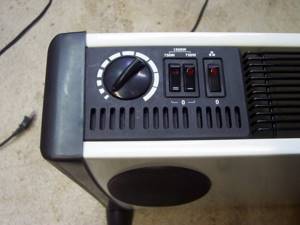
When choosing a device, pay attention to such an important characteristic as power
- electricity consumption. In this regard, the convector is about a quarter more economical than an oil radiator of the same power. This factor may turn out to be decisive, since the significant energy consumption of an oil-based device can cost a pretty penny;
- ease of installation and operation. Convectors weigh several times less than bulky oil-based appliances, which is why moving them from place to place is much more convenient. They are also easier to mount on a wall, although this does reduce efficiency. Modern models of both types of devices are equipped with sensors, simple and clear controls and displays, so the level of ease of use is approximately the same and largely depends on the manufacturer and model;
- safety of use. The answer to the question of which oil heaters are better may well be those that heat up less during operation. Hot oil noticeably heats up the housing, but convectors are completely safe in this regard. You can easily leave such a device turned on unattended, while doing this with oil-based ones is highly not recommended;
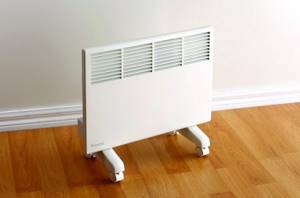
Compared to oil heaters, convector heaters are safer
- environmental friendliness and health safety. Oil or convector heaters do not have parts in their design that could burn oxygen, so in this regard, both types are completely safe. When a convector is operating, dust can circulate in the room, which does not happen when an oil heater is operating. But here a lot depends on the cleanliness of the room;
- durability. Convector heaters last significantly longer than oil heaters, and they are much easier to repair. One of the most common causes of oil cooler failure can be the occurrence of microcracks through which oil leaks and evaporates. Repair in such cases is very difficult or simply impossible;
- price. Oil radiators are cheaper than convectors of the same power, but in terms of overall performance characteristics they are significantly inferior to them, so the savings can be very doubtful.
In addition to the characteristics already listed, it is worth noting that the improvement of convector heating devices is happening much faster than oil ones, which are slowly but surely disappearing from the market. The latest invention in this regard is the monolithic heating element of the convector, which doubles the thermal power of the device with the same electricity consumption.

The device of a modern convector heater
In addition, when choosing a convector or oil heater, you need to take into account the degree of protection, and in terms of this characteristic the latter clearly loses. It is a rare convector that is not equipped with protection against overheating, voltage surges and tipping over. While oil radiators are often found without protection at all.


